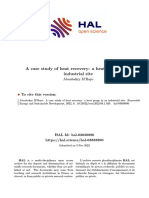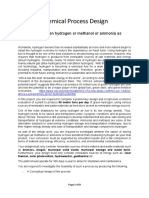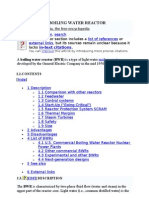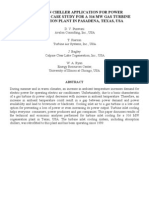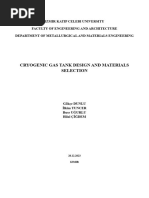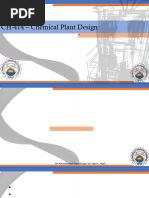Introduction To Heat Exchangers: Types, Classification and Analysis
Uploaded by
PrinceJohnIntroduction To Heat Exchangers: Types, Classification and Analysis
Uploaded by
PrinceJohnME 437: Design and Rating of Heat Exchangers 1.
CASE STUDY 1
Introduction to Heat Exchangers: Types, Classification and Analysis
Objectives
In this chapter we will introduce heat exchangers that transfer heat from a hot fluid to the
cold fluid; different types of heat exchangers will be introduced; in addition to the
concept of total thermal resistance or overall heat-transfer coefficient in exchanger
analysis as well as the log-mean-temperature difference method of analysis for design
calculations.
1.1 Introduction
The technology of heating and cooling of systems is one of the most basic areas of
mechanical engineering. Wherever steam is used, or wherever hot or cold fluids are
required we will find a heat exchanger. They are used to heat and cool homes, offices,
markets, shopping malls, cars, trucks, trailers, aero-planes, and other transportation
systems. They are used to process foods, paper, petroleum, and in many other industrial
processes. They are found in superconductors, fusion power labs, spacecrafts, and
advanced computer systems. The list of applications, in both low and high tech industries,
is practically endless.
In our basic study of thermodynamics and heat transfer, we studied the form of the
control volume energy balance and its application too many engineering problems,
including to a basic heat exchanger problem. In this module, we will extend heat
exchanger analysis to include the convection rate equation, and demonstrate the
methodology for predicting heat exchanger performance that include both design and
performance rating problems.
1.2 Heat Exchanger Types
Heat exchangers are typically classified according to flow arrangement and type of
construction. In this introductory treatment, we will consider three types that are
representative of a wide variety of exchangers used in industrial practice. The simplest
heat exchanger is one for which the hot and cold fluids flow in the same or opposite
directions in a concentric-tube (or double-pipe) construction. In the parallel-flow
arrangement of Figure 1.1a, the hot and cold fluids enter at the same end, flow in the
same direction, and leave at the same end. In the counterflow arrangement, Figure 1.1b,
the fluids enter at opposite ends, flow in opposite directions, and leave at opposite ends.
A common configuration for power plant and large industrial applications is the shelland-tube heat exchanger, shown in Figure 1.1c. This exchanger has one shell with
multiple tubes, but the flow makes one pass through the shell. Baffles are usually
installed to increase the convection coefficient of the shell side by inducing turbulence
Case Study No. 1
ME 437: Design and Rating of Heat Exchangers 1.2
and a cross-flow velocity component. The cross-flow heat exchanger, Figure 1.1d, is
constructed with a stack of thin plates bonded to a series of parallel tubes. The plates
function as fins to enhance convection heat transfer and to ensure cross-flow over the
tubes. Usually it is a gas that flows over the fin surfaces and the tubes, while a liquid
flows in the tube. Such exchangers are used for air-conditioner and refrigeration heat
rejection applications.
Figure 1.1 Types of heat exchangers (a) concentric-tube parallel-flow; (b) concentrictube counter-flow; (c) shell-and-tube; and (d) cross flow.
1.3 Heat Exchanger Analysis Overall Heat Transfer Coefficient
The total heat transfer resistance is the sum of the individual components as shown in
Figure 2; i.e., resistance of the inside flow, the conduction resistance in the tube material,
and the outside convective resistance, given by
1
1
t
1
= Rtotal =
+
+
UA
Ai hi kAln Ao ho
(1.1)
where subscripts i and o refer to inner and outer heat-transfer surface areas, respectively, t
is the wall thickness, and Aln is the logarithmic mean heat transfer area, defined as
( Ao Ai )
(1.2)
Ao
ln
Ai
The total heat transfer resistance can be defined in terms of overall heat transfer
coefficient based on either outer or inner areas, as long as the basis is clearly spelled out.
For example, based on outer area, we have
Aln =
Case Study No. 1
ME 437: Design and Rating of Heat Exchangers 1.3
Figure 1.2 Typical heat transfer resistances when heat flows from a hot to cold fluid.
A
tA
1
1
= Ao Rtotal = o + o +
Ai hi kAln ho
Uo
(1.3)
which after simplifying yields the overall heat transfer coefficient based on inner and
outer areas, respectively as
Ui =
1
Di
1 Di ln( Do / Di )
+
+
hi
2k
Do ho
(1.4)
and
Uo =
1
Do
D ln( Do / Di ) 1
+ o
+
Di hi
2k
ho
(1.5)
where the inner and outer heat-transfer areas, as well as the wall thickness, and the
logarithmic mean heat transfer area, in terms of tube inner and out diameters and length
L, are given, respectively, as
Ai = Di L
(1.6.1)
Ao = Do L
(1.6.2)
Do Di
2
(1.6.3)
t=
Aln =
Case Study No. 1
( Do Di ) L
D
ln o
Di
(1.6.4)
ME 437: Design and Rating of Heat Exchangers 1.4
We note from the above equations that if the wall thickness is negligible ( Do Di ) , for
example, in thin tube heat exchangers or the thermal conductivity of the tube material is
very high, the conduction resistance through the tube may be neglected in Equations (1.4)
and (1.5) to give
1
1
1
1
= +
U i U o hi ho
(1.7)
The convection coefficients for the inlet and outlet side of the heat exchanger tube can be
estimated using empirical correlations appropriate for the flow geometry and conditions.
During normal heat exchanger operation, surfaces are subjected to fouling by fluid
impurities, rust formation, and scale depositions, which can markedly increase the
resistance to heat transfer between the fluids. For such situations, one would add the
fouling resistance (inside and/or outside-side) to Equations 1.3 to give
Rtotal
R "f ,i
R "f ,o
1
t
1
=
+
+
+
+
Ai hi
Ai
kAln
A0
Ao ho
(1.8)
where R "f ,i and R "f ,o are the inside and outside fouling resistances per unit respective
heat-transfer areas, in m2.K/W. In actual applications, fouling is normally on one-side of
the heat-transfer surface. Therefore, if the overall heat transfer coefficient based on the
clean condition is, Uc, determined typically based on outer tube area (refer to Equation
1.5), the time-dependent U based on fouled condition can be written as
1
1
=
+ R 'f' (t )
U f (t ) U c
(1.9)
It is important to emphasize that fouling or scaling is the most common in heat exchanger
applications. For instance, scaling is typically associated with inverse solubility salts,
such as CaCO3, CaSO4, Ca3(PO4)2, CaSiO3, Ca(OH)2, Mg(OH)2, MgSiO3, Na2SO4,
LiSO4, and Li2CO3. The characteristic which is termed inverse solubility is that, unlike
most inorganic materials, the solubility decreases with temperature. The most important
of these compounds is calcium carbonate, CaCO3. Calcium carbonate exists in several
forms, but one of the more important is limestone. As water runs through aquifers,
running primarily through openings in limestone rock, it becomes saturated with calcium
carbonate. This saturated water if pumped from the ground and passed through a heat
exchanger, becomes supersaturated as it is heated, so that CaCO3 begins to crystallize on
heat exchanger internal passages. Similar results occur when ground water is used in any
industrial cooling process.
Case Study No. 1
ME 437: Design and Rating of Heat Exchangers 1.5
Most of the actual data on fouling resistances or fouling factors is tightly held be a few
specialty consulting companies. The data which is commonly available is sparse. An
example is shown in Table 1.1 for some typical industrial applications.
Note that the data in the table is given to only one significant figure. It is standard
engineering practice to indicate the precision of a number by the number of significant
figures presented, i.e. 0.0001 would indicate a number between 0.00005 and 0.00015.
Actually these numbers are not known to this precision. Nevertheless, this data is often
the best that is openly available and it is used for heat exchanger design calculations.
Table 1.1 Representative Fouling Factors from Incropera and DeWitt [1]
Fluid
Seawater and treated boiler feed-water (below 50oC)
Seawater and treated boiler feed-water (above 50oC)
River water (below 50oC)
Fuel Oil
Refrigerating liquids
Steam (non-oil bearing)
R "f ,
m2.K/W
0.0001
0.0002
0.0002-0.001
0.0009
0.0002
0.0001
1.4 Energy Equations for Heat Exchangers
The general heat exchanger equation is written in terms of the mean-temperature
difference between the hot and cold fluid, Tm , as
Q = UA Tm
(1.10)
This equation, combined with the First Law equations, defines the energy flows for a heat
exchanger (refer to Figure 2). For the hot fluid the First Law equation is written in terms
of the temperature change the hot fluid undergoes, Th as:
Q = (m& C p ) h Th = C& h Th
(1.11)
And for the cold fluid the First Law equation can be written in terms of the cold fluid
temperature change, Tc as:
Q = (m& C p ) c Tc = C& c Tc
(1.12)
where C& h and C& c are the hot and cold fluid capacitance rates, respectively.
Case Study No. 1
ME 437: Design and Rating of Heat Exchangers 1.6
1.5 Log Mean Temperature Differences
Heat flows between the hot and cold streams due to the temperature difference across the
tube acting as a driving force. As seen in Figure 3, the difference will vary with axial
location so that one must speak in terms of the effective or integrated average
temperature differences.
Figure 1.3 Temperature differences between hot and cold process streams
Case Study No. 1
ME 437: Design and Rating of Heat Exchangers 1.7
The form of the average temperature difference, Tm , may be determined by applying an
energy balance to differential control volumes (elements ) in the hot and cold fluids. As
shown in Figure 1.3, for the case of parallel flow arrangement, each element is of length
dx and the heat transfer surface area is dA. It follows for the hot fluid
dQ = C& h dTh
(1.13)
dQ = C& c dTc
(1.14)
and for the cold fluid
The heat transfer across the surface area dA may be expressed by the convection rate
equation in differential form
dQ = UdA dT
(1.15)
where dT = Th - Tc is the local temperature difference between the hot and cold fluids.
To determine the integrated form of Equation 1.15, we begin by substituting Equations
1.13 and 1.14 into the differential form for the temperature difference,
d (T ) = d (Th Tc )
(1.16)
to obtain
1
1
+
d (T ) = dTh dTc = dQ
&
&
C
C
c
h
(1.17)
Substituting for dQ from Equation 1.115 and integrating across the exchanger area, we
obtain
A
1
d (T )
1
+
U
dA
1 T
C&
&
h Cc 0
2
1
T
1
+
ln 2 = UA
&
&
T1
C h Cc
Case Study No. 1
(1.18)
ME 437: Design and Rating of Heat Exchangers 1.8
Substituting C& h and C& c from the fluid energy balances, Equations 1.13 and 1.14,
respectively, it follows that
T
(Th ,i Th ,o ) (Tc ,o Tc ,i )
+
ln 2 = UA
Q
Q
T1
T
ln 2
T1
UA
=
((Th,i Tc,i ) (Th,o Tc,o ))
Q
(1.19)
Rearranging this expression and noting, from Figure 1.3 for the parallel-flow exchanger,
that
T1 = (Th ,i Tc ,i ) and T2 = (Th ,o Tc ,o )
(1.20)
we obtain on using Equation (1.20), and rearranging Equation (1.20), to give
T UA
(T2 T1 )
ln 2 =
T
Q
1
or
Q = UA
(T2 T1 )
ln T2
T1
(1.21)
Comparing the above expression with Equation 1.10, we conclude that the appropriate
mean temperature difference is the log mean temperature difference, Tm = Tlm .
Accordingly, we have
Tm = Tlm =
(T2 T1 )
(T1 T2
=
ln T1
ln T2
T
T
1
2
(1.21)
A similar derivation can be shown for counter-flow heat exchangers; however, the
temperature difference as shown in Figure 1.3, will be
Case Study No. 1
ME 437: Design and Rating of Heat Exchangers 1.9
T1 = (Th ,i Tc , 0 ) and T2 = (Th ,o Tc ,i )
(1.22)
As discussed above, the effective mean temperature difference calculated from this
equation is known as the log mean temperature difference, frequently abbreviated as
LMTD, based on the type of mathematical average which it describes. While the
equation applies to either parallel or counter flow, it can be shown that Tm will always
be greater in the counter flow arrangement. This can be shown theoretically from Second
Law considerations but, for the undergraduate student, it is generally more satisfying to
arbitrarily choose a set of temperatures and check the results from the two equations. The
only restrictions that we place on the case are that it be physically possible for parallel
flow, i.e. 1 and 2 must both be positive.
Example 1.1: We are interested in cooling a light oil (this time with Cp = 1100 J/kg K,
just to make it interesting) with water in a heat exchanger. The oil flows at 0.5 kg/s and is
cooled from 375K to 350K. The water starts out at 280K and flows at 0.2 kg/s. We would
like to determine the difference in area between a co-current (parallel flow) exchanger
and a counter-current exchanger, if the overall heat transfer coefficient is 100 W/m2K.
Solution
Known: Fluid flow rates and inlet temperatures for a heat exchanger (having either
counter-flow or parallel-flow arrangement), as well as the outlet hot flow temperature.
Schematic and Given Data:
Specific heat of light oil, Cp = 1100 J/kg K; and the overall heat transfer coefficient of the
heat exchanger under both configuration, U = 100 W/m2K.
Assumptions:
Negligible heat loss to the surroundings.
Negligible kinetic and potential energy effects.
No shaft work.
Constant properties.
Negligible tube wall thermal resistance and fouling factors.
Fully developed conditions for water flow.
Analysis:
Note that, in this problem hot fluid is light oil while the cold fluid is water. We start with
a macroscopic thermal energy balance (refer to Equations (1.11) and 1.12) to find the
water outlet temperature. This gives
Tc ,o =
Case Study No. 1
(m& C p ) h (Th ,i Th ,o )
(m& C p ) c
+ Tc ,i
ME 437: Design and Rating of Heat Exchangers 1.10
Plugging the numbers, we get
Tc ,o =
(0.5 kg/s)(1.1 kJ/kg.K) (375 350)K
+ 280 K = 296.37 K
(0.2 kg/s)(4.2 kJ/kg.K)
We then need to calculate the total heat duty of the exchanger either by Equation (1.11)
or (1.12), to give
Q = C& h Th = C& c Tc
or
Q = (0.5 kg/s)(1.1 kJ/kg.K)(350 375) K
= (0.2 kg/s)(4.2 kJ/kg.K)(296.37 280) K = 13.75 kW
Finally, we use the heat duty, the overall heat transfer coefficient, and the log-mean
temperature difference to obtain the necessary heat-transfer areas for both the
configurations. The heat duty is given by Equation 1.21, to give
Q = UA
(T2 T1 )
ln T2
T1
or, it can be arranged to give
A=
Q
UTlm
where Tlm is given by
Tlm =
(T2 T1 )
ln T2
For counter-flow, we have
T1 = (Th ,i Tc , 0 ) = (375 296.37) K = 78.63 K
T2 = (Th ,o Tc ,i ) = (350 280) K = 70 K
and finally the log-mean-temperature difference and heat exchanger area as
Tlm =
(70 78.63)
= 74.23 K ,
ln 70
78.63
For parallel-flow heat exchanger, we have
Case Study No. 1
A=
1,3750 W
= 1.85 m 2
2
(100 W/m K)(74.23 K)
ME 437: Design and Rating of Heat Exchangers 1.11
T1 = (Th ,i Tc ,i ) = (375 280) K = 95 K
T2 = (Th ,o Tc ,o ) = (350 296.37) K = 53.63 K
and the log-mean-temperature difference
Tlm =
(95 53.63)
= 72.35 K
ln 95
53.63
This gives
A=
1,3750 W
= 1.90 m 2
2
(100 W/m K)(72.35 K)
This simple example shows that the counter-current system necessitates a (slightly)
smaller area. Another interesting observation from the above example is that counter flow
is more appropriate for maximum energy recovery. In a number of industrial applications
there will be considerable energy available within a hot waste stream which may be
recovered before the stream is discharged. This is done by recovering energy into a fresh
cold stream. Note in the Figures shown above that the hot stream may be cooled to Tc,i
for counter flow, but may only be cooled to Tc,o for parallel flow. Counter flow allows
for a greater degree of energy recovery. Similar arguments may be made to show the
advantage of counter flow for energy recovery from refrigerated cold streams.
1.4.1 Applications for Counter and Parallel Flows
We have seen two advantages for counter flow, (a) larger effective LMTD and (b) greater
potential energy recovery. The advantage of the larger LMTD, as seen from the heat
exchanger equation, is that a larger LMTD permits a smaller heat exchanger area, A, for a
given thermal duty, Q. This would normally be expected to result in smaller, less
expensive equipment for a given application.
This should not lead to the assumption that counter flow is always a superior. Parallel
flows are advantageous (a) where the high initial heating rate may be used to advantage
and (b) where the more moderate temperatures developed at the tube walls are required.
In heating very viscous fluids, parallel flow provides for rapid initial heating. The quick
decrease in viscosity which results may significantly reduce pumping requirements
through the heat exchanger. The decrease in viscosity also serves to shorten the distance
required for flow to transition from laminar to turbulent, enhancing heat transfer rates.
Where the improvements in heat transfer rates compensate for the lower LMTD parallel
flow may be used to advantage.
A second feature of parallel flow may occur due to the moderation of tube wall
temperatures. As an example, consider a case where convective coefficients are
approximately equal on both sides of the heat exchanger tube. This will result in the
tube wall temperatures being about the average of the two stream temperatures. In the
Case Study No. 1
ME 437: Design and Rating of Heat Exchangers 1.12
case of counter flow the two extreme hot temperatures are at one end, the two extreme
cold temperatures at the other. This produces relatively hot tube wall temperatures at one
end and relatively cold temperatures at the other. Temperature sensitive fluids, notably
food products, pharmaceuticals and biological products, are less likely to be scorched
or thermally damaged in a parallel flow heat exchanger. Chemical reaction fouling
may be considered as leading to a thermally damaged process stream. In such cases,
counter flow may result in greater fouling rates and, ultimately, lower thermal
performance. Other types of fouling are also thermally sensitive. Most notable are
scaling, corrosion fouling and freezing fouling.
1.5 Special Heat Exchanger Operating Conditions
In Figure 1.4, the temperature distributions associated with three special conditions under
which heat exchangers may be operated, are shown.
Ch > Cc. For this case, the hot fluid capacity rate Ch is much larger than the cold fluid
capacity rate Cc. As shown in Figure 1.4a, the hot fluid temperature remains
approximately constant throughout the exchanger, while the temperature of the cold fluid
increases. The same condition could be achieved if the hot fluid is a condensing vapor.
Condensation occurs at a constant temperature, and for all practical purposes, Ch .
Ch < Cc. For this case, as shown in Figure 1.4b, the cold fluid temperature remains
approximately constant throughout the exchanger, while the temperature of the hot fluid
decreases. The same effect is achieved if the cold fluid experiences evaporation for
which Cc . Note that with evaporation and condensation, the fluid energy balances
can only be written in terms of the phase change enthalpies.
Ch = Cc. The third case, Figure 1.4c, involves a counter-flow exchanger for which the
heat capacity rates are equal. The temperature difference T must be constant
throughout the exchanger, in which case, T1 = T2 = Tm .
Figure 1.4 Special heat exchanger conditions (a) Ch >> Cc; (b) Ch << Cc; and (c) Ch = Cc.
Case Study No. 1
ME 437: Design and Rating of Heat Exchangers 1.13
1.6 References
[1]
[2]
[3]
Incropera, F. P. and D. P. DeWitt, Fundamentals of Heat and Mass Transfer, 5th
Edition, John Wiley and Sons Inc., New York, 2002.
Thomas, L.C., Heat Transfer Professional Version, 2nd edition, Capstone
Publishing Corp, 1999.
engel, Yunus A., Heat Transfer: A Practical Approach, 2nd edition, McGrawHill, New York, 2003.
Case Study No. 1
You might also like
- 1 DIESEL EMISSIONS TECHNOLOGY Sulzer 33No ratings yet1 DIESEL EMISSIONS TECHNOLOGY Sulzer 3333 pages
- Pressure Drop in Water Gas Shift Reactor (Jason Keith)No ratings yetPressure Drop in Water Gas Shift Reactor (Jason Keith)6 pages
- Detailed Notes - Section 03 Waves - AQA Physics A-Level PDFNo ratings yetDetailed Notes - Section 03 Waves - AQA Physics A-Level PDF12 pages
- Advanced Vibration Analysis On Gear Box TrainNo ratings yetAdvanced Vibration Analysis On Gear Box Train25 pages
- Solutions For Classical Mechanics - Goldstein.H (2 Edition)0% (1)Solutions For Classical Mechanics - Goldstein.H (2 Edition)10 pages
- Performance Analysis of A Waste Heat Recovery Thermoelectric Generation System For Automotive ApplicationNo ratings yetPerformance Analysis of A Waste Heat Recovery Thermoelectric Generation System For Automotive Application7 pages
- Second Law Analysis of A Waste Heat Recovery BasedNo ratings yetSecond Law Analysis of A Waste Heat Recovery Based9 pages
- Performance Analysis of Plate Heat Exchangers Used As Refrigerant Evaporators100% (1)Performance Analysis of Plate Heat Exchangers Used As Refrigerant Evaporators295 pages
- A Case Study of Heat Recovery A Heat Pump in An Inductrial SiteNo ratings yetA Case Study of Heat Recovery A Heat Pump in An Inductrial Site11 pages
- Optimization of Air Preheater Design For The Enhancement of Heat Transfer CoefficientNo ratings yetOptimization of Air Preheater Design For The Enhancement of Heat Transfer Coefficient10 pages
- An Analytical Study On Heat Transfer Performance ofNo ratings yetAn Analytical Study On Heat Transfer Performance of18 pages
- Syllabus Waste Heat Recovery: Classification, Advantages and Applications, Commercially100% (2)Syllabus Waste Heat Recovery: Classification, Advantages and Applications, Commercially18 pages
- Production of Synthesis Gas: Caalysis Today, 18 (1993) 305-324No ratings yetProduction of Synthesis Gas: Caalysis Today, 18 (1993) 305-32420 pages
- Investigation On The Heating Performance of The Heat Pump Withwaste Heat Recovery For The Electric BusNo ratings yetInvestigation On The Heating Performance of The Heat Pump Withwaste Heat Recovery For The Electric Bus14 pages
- HRCEN82-22 Design Project Green Hydrogen ProductionNo ratings yetHRCEN82-22 Design Project Green Hydrogen Production9 pages
- Water Gas Shift Reaction Kinetics and Reactor Modeling For Fuel Cell Grade Hydrogen PDFNo ratings yetWater Gas Shift Reaction Kinetics and Reactor Modeling For Fuel Cell Grade Hydrogen PDF8 pages
- Integration of Gasification With Thermal Residue Conversion in RefineriesNo ratings yetIntegration of Gasification With Thermal Residue Conversion in Refineries15 pages
- Heat Engines: A Brief Review of ThermodynamicsNo ratings yetHeat Engines: A Brief Review of Thermodynamics15 pages
- Theoretical Thermodynamic Analysis of Rankine Power Cycle100% (1)Theoretical Thermodynamic Analysis of Rankine Power Cycle7 pages
- Catalytic Hydrocracking Mechanisms and VNo ratings yetCatalytic Hydrocracking Mechanisms and V15 pages
- Distillation Dynamics and Control Workbook 2006 PDFNo ratings yetDistillation Dynamics and Control Workbook 2006 PDF18 pages
- Models - Chem.multicomponent Tubular ReactorNo ratings yetModels - Chem.multicomponent Tubular Reactor23 pages
- ME495 Lab - Plate Heat Exchanger - Expt Number 5No ratings yetME495 Lab - Plate Heat Exchanger - Expt Number 55 pages
- Multiphase Reactor Engineering for Clean and Low-Carbon Energy ApplicationsFrom EverandMultiphase Reactor Engineering for Clean and Low-Carbon Energy ApplicationsYi ChengNo ratings yet
- Design and Control of Distillation Systems for Separating AzeotropesFrom EverandDesign and Control of Distillation Systems for Separating AzeotropesNo ratings yet
- Shell-and-Tube Heat Exchangers R. Shankar Subramanian: AdvantagesNo ratings yetShell-and-Tube Heat Exchangers R. Shankar Subramanian: Advantages10 pages
- Experiment 2-Double Pipe Heat Exchanger 2No ratings yetExperiment 2-Double Pipe Heat Exchanger 222 pages
- Heat and Mass Transfer: Haramay University Haramaya Institute of TechnologyNo ratings yetHeat and Mass Transfer: Haramay University Haramaya Institute of Technology50 pages
- Coulombic Attraction and Periodicity DefinitionsNo ratings yetCoulombic Attraction and Periodicity Definitions3 pages
- AP Physics 1investigation5impulseandmomentumNo ratings yetAP Physics 1investigation5impulseandmomentum15 pages
- Seismic Design Criteria (Changes From 1.6 To 1.7)No ratings yetSeismic Design Criteria (Changes From 1.6 To 1.7)79 pages
- Seismic Characterization Chelyabinsk MeteorNo ratings yetSeismic Characterization Chelyabinsk Meteor6 pages
- IIT Alumni Centre, Bengaluru Webinar Book-Volume 1No ratings yetIIT Alumni Centre, Bengaluru Webinar Book-Volume 1374 pages
- Quantum Chemistry: Dr. Rohul Hayat Adnan Department of Chemistry UTMNo ratings yetQuantum Chemistry: Dr. Rohul Hayat Adnan Department of Chemistry UTM7 pages
- Prediction of Static Liquefaction by Nor Sand Constitutive ModelNo ratings yetPrediction of Static Liquefaction by Nor Sand Constitutive Model9 pages
- Disha Publication Previous Years Problems On System of Particles and Rotional Motion For NEET. CB1198675309No ratings yetDisha Publication Previous Years Problems On System of Particles and Rotional Motion For NEET. CB11986753097 pages
- Molecular Transport Equation and General Property Balance100% (1)Molecular Transport Equation and General Property Balance56 pages
- Pressure Drop in Water Gas Shift Reactor (Jason Keith)Pressure Drop in Water Gas Shift Reactor (Jason Keith)
- Detailed Notes - Section 03 Waves - AQA Physics A-Level PDFDetailed Notes - Section 03 Waves - AQA Physics A-Level PDF
- Solutions For Classical Mechanics - Goldstein.H (2 Edition)Solutions For Classical Mechanics - Goldstein.H (2 Edition)
- Performance Analysis of A Waste Heat Recovery Thermoelectric Generation System For Automotive ApplicationPerformance Analysis of A Waste Heat Recovery Thermoelectric Generation System For Automotive Application
- Second Law Analysis of A Waste Heat Recovery BasedSecond Law Analysis of A Waste Heat Recovery Based
- Performance Analysis of Plate Heat Exchangers Used As Refrigerant EvaporatorsPerformance Analysis of Plate Heat Exchangers Used As Refrigerant Evaporators
- A Case Study of Heat Recovery A Heat Pump in An Inductrial SiteA Case Study of Heat Recovery A Heat Pump in An Inductrial Site
- Optimization of Air Preheater Design For The Enhancement of Heat Transfer CoefficientOptimization of Air Preheater Design For The Enhancement of Heat Transfer Coefficient
- An Analytical Study On Heat Transfer Performance ofAn Analytical Study On Heat Transfer Performance of
- Syllabus Waste Heat Recovery: Classification, Advantages and Applications, CommerciallySyllabus Waste Heat Recovery: Classification, Advantages and Applications, Commercially
- Production of Synthesis Gas: Caalysis Today, 18 (1993) 305-324Production of Synthesis Gas: Caalysis Today, 18 (1993) 305-324
- Investigation On The Heating Performance of The Heat Pump Withwaste Heat Recovery For The Electric BusInvestigation On The Heating Performance of The Heat Pump Withwaste Heat Recovery For The Electric Bus
- HRCEN82-22 Design Project Green Hydrogen ProductionHRCEN82-22 Design Project Green Hydrogen Production
- Water Gas Shift Reaction Kinetics and Reactor Modeling For Fuel Cell Grade Hydrogen PDFWater Gas Shift Reaction Kinetics and Reactor Modeling For Fuel Cell Grade Hydrogen PDF
- Integration of Gasification With Thermal Residue Conversion in RefineriesIntegration of Gasification With Thermal Residue Conversion in Refineries
- Theoretical Thermodynamic Analysis of Rankine Power CycleTheoretical Thermodynamic Analysis of Rankine Power Cycle
- Distillation Dynamics and Control Workbook 2006 PDFDistillation Dynamics and Control Workbook 2006 PDF
- Multiphase Reactor Engineering for Clean and Low-Carbon Energy ApplicationsFrom EverandMultiphase Reactor Engineering for Clean and Low-Carbon Energy Applications
- Design and Control of Distillation Systems for Separating AzeotropesFrom EverandDesign and Control of Distillation Systems for Separating Azeotropes
- Problem Solving for Process Operators and SpecialistsFrom EverandProblem Solving for Process Operators and Specialists
- Shell-and-Tube Heat Exchangers R. Shankar Subramanian: AdvantagesShell-and-Tube Heat Exchangers R. Shankar Subramanian: Advantages
- Heat and Mass Transfer: Haramay University Haramaya Institute of TechnologyHeat and Mass Transfer: Haramay University Haramaya Institute of Technology
- IIT Alumni Centre, Bengaluru Webinar Book-Volume 1IIT Alumni Centre, Bengaluru Webinar Book-Volume 1
- Quantum Chemistry: Dr. Rohul Hayat Adnan Department of Chemistry UTMQuantum Chemistry: Dr. Rohul Hayat Adnan Department of Chemistry UTM
- Prediction of Static Liquefaction by Nor Sand Constitutive ModelPrediction of Static Liquefaction by Nor Sand Constitutive Model
- Disha Publication Previous Years Problems On System of Particles and Rotional Motion For NEET. CB1198675309Disha Publication Previous Years Problems On System of Particles and Rotional Motion For NEET. CB1198675309
- Molecular Transport Equation and General Property BalanceMolecular Transport Equation and General Property Balance













